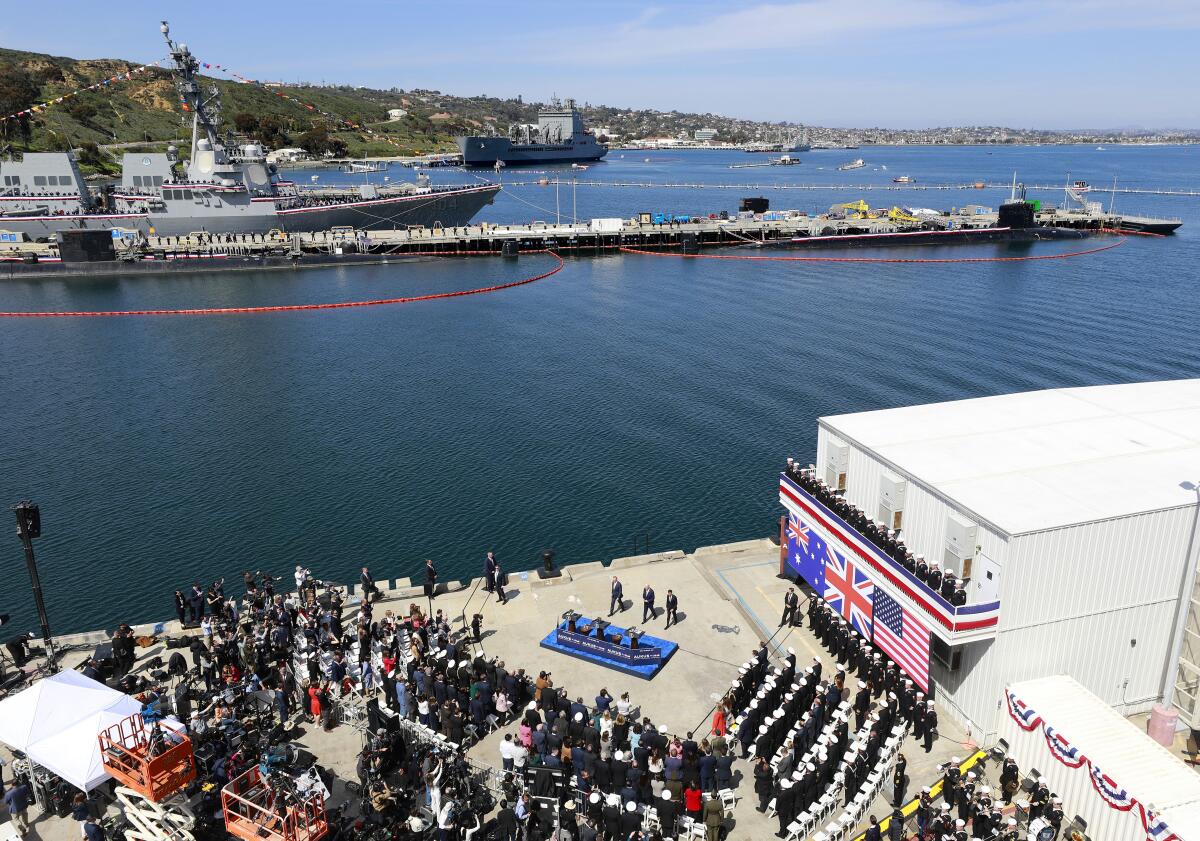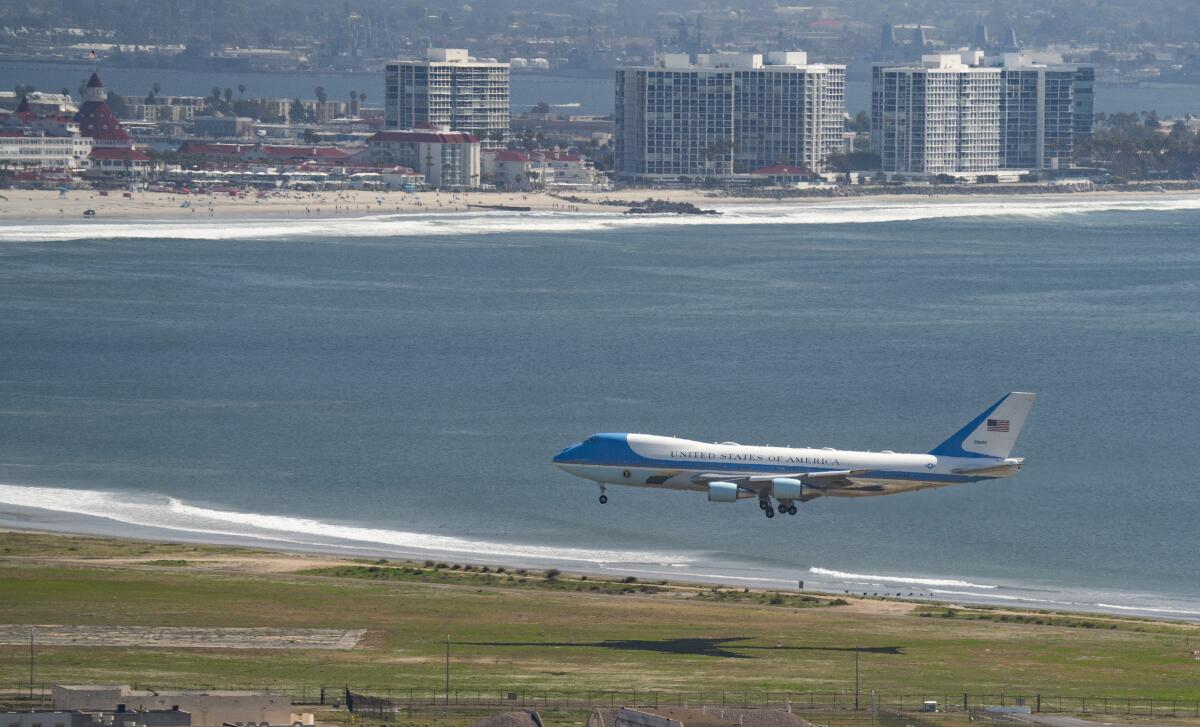Biden and U.K., Australia unveil submarine security pact during historic San Diego visit

- Share via
At a historic meeting in San Diego, President Biden and the prime ministers of the United Kingdom and Australia announced Monday that they’re accelerating plans to provide Australia with nuclear-powered submarines to help the nations counter a military buildup by China in the Indo-Pacific.
Australia will initially buy three U.S. Virginia-class submarines that will be armed with conventional weapons but no nuclear missiles. Contracts for two more multibillion-dollar subs can be added at a later date.
The three countries will also collaborate on the design of a new submarine built with components from each nation that will require the U.S. to share highly sensitive technology with the U.K. and Australia, which are long-standing NATO allies. The U.S. hasn’t made this kind of deal since it helped the U.K. with nuclear submarine development in 1958.
The first of the new subs will be constructed in the U.K. with others to follow in Australia. Construction will begin in the early 2030s because the U.K. needs to expand its industrial capacity and Australia needs to create the ability to build vessels of this magnitude.
Monday’s agreement stems from the so-called Australia-United Kingdom-United States, or AUKUS, partnership, which was formed in late 2021 with the goal of collectively finding ways to maintain peace and stability in the Indo-Pacific, a huge continental portion of Southeast Asia.

Biden praised the partnership as he stood between British Prime Minister Rishi Sunak and Australian Prime Minister Anthony Albanese on a pier at Naval Base San Diego on Point Loma in a very rare and public joint address. He called AUKUS “a powerful entity” and noted how much progress it has made in such a short period of time.
“Australia and the United Kingdom are two of America’s most stalwart and capable allies,” Biden said to the crowd of about 150 dignitaries, naval officials and members of Congress. They included Defense Secretary Lloyd J. Austin III, Navy Secretary Carlos Del Toro, and Caroline Kennedy, U.S. ambassador to Australia.
“AUKUS has one overriding goal: to enhance stability in the Indo-Pacific amid rapidly shifting dynamics,” he added.
The pact is propelled by concerns that China could, at some point, invade Taiwan, sparking a global military crisis. The allies also say that the military bases China is building on artificial islands in the South China Sea could be used to thwart trade and the movement of ships and aircraft in that part of the world.
“This is a very, very big deal,” said Tai Ming Cheung, a China expert at UC San Diego.
“The U.S. has primarily — as we’ve seen with NATO — engaged with militaries in alliances but has not historically been willing to engage in industrial partnerships and sharing the most sensitive, technological secrets.”

He added that, “The U.S. has to have a more global footprint [militarily]. It needs a lot more allies to help them in the Indo-Pacific.”
The U.S. currently has 71 submarines. China is rapidly building its own vessels and is expected to surpass the U.S. in the total number of subs by the end of this decade.
The deal “is being undertaken to help our closet allies [be] more powerful and capable of convincing Beijing that it’s no longer operating in a permissive security environment,” Charles Edel, a senior advisor for the Center for Strategic and International Studies in Washington, D.C., said at a news briefing.
The new security pact will be carried out in three phrases. The first is just getting underway as the U.S. begins to have American submarines visit bases in Australia. The U.K will do the same. Australian sailors will embed with the navies of both countries and study at schools specializing in nuclear-powered subs, the Biden administration said. In 2027, the U.S. and U.K. will begin placing their own subs at Australian ports on a rotating basis.
Australia has six Collins-class diesel submarines, which do not come close to matching the offensive and defensive capabilities of America’s various types of nuclear “boats,” including the four Los Angeles-class vessels homeported in San Diego.
Those subs operate out of Naval Base San Diego in San Diego Bay.
The U.S. builds submarines in Virginia and Connecticut, which are at or near capacity, defense analysts say. First Lady Jill Biden is a sponsor of a Virginia-class sub, the USS Delaware, the president noted Monday, “and she never lets me forget it.”

Air Force One touched down at 12:05 p.m. at nearby Naval Air Station North Island in Coronado. Biden was greeted on the tarmac by Naval Surface Forces commander Vice Adm. Roy Kitchener and Capt. Charles McKissick, commanding officer of Naval Base Coronado. He then left in the motorcade toward Point Loma with his daughter, Ashley Biden, and granddaughter, Natalie, who is on spring break.
The motorcade passed small groups of protesters on the route, including a few supporters of former President Trump and those protesting new border wall construction at Friendship Park. Other people filmed the procession along the city streets on their phones and waved.
Biden was set to meet separately with Albanese and Sunak after their 1:45 p.m. joint appearance. He will then be greeted by San Diego Mayor Todd Gloria and other local elected officials at San Diego International Airport late in the afternoon.
Biden will wrap up his visit to San Diego by attending a Democratic National Committee reception in Rancho Santa Fe on Monday evening.
On Tuesday the president is scheduled to visit Monterey Park, the site of a mass shooting that killed 11 people and injured nine.
Los Angeles Times staff writer Tracy Wilkinson contributed to this report.
More to Read
Updates
4:03 p.m. March 13, 2023: This story has been updated with Biden’s remarks.
4:03 p.m. March 13, 2023: This story has been updated with details on the sub agreement.
4:03 p.m. March 13, 2023: This story has been updated with Biden’s arrival in San Diego.
4:03 p.m. March 13, 2023: This story was updated with additional details.
Sign up for Essential California
The most important California stories and recommendations in your inbox every morning.
You may occasionally receive promotional content from the Los Angeles Times.















